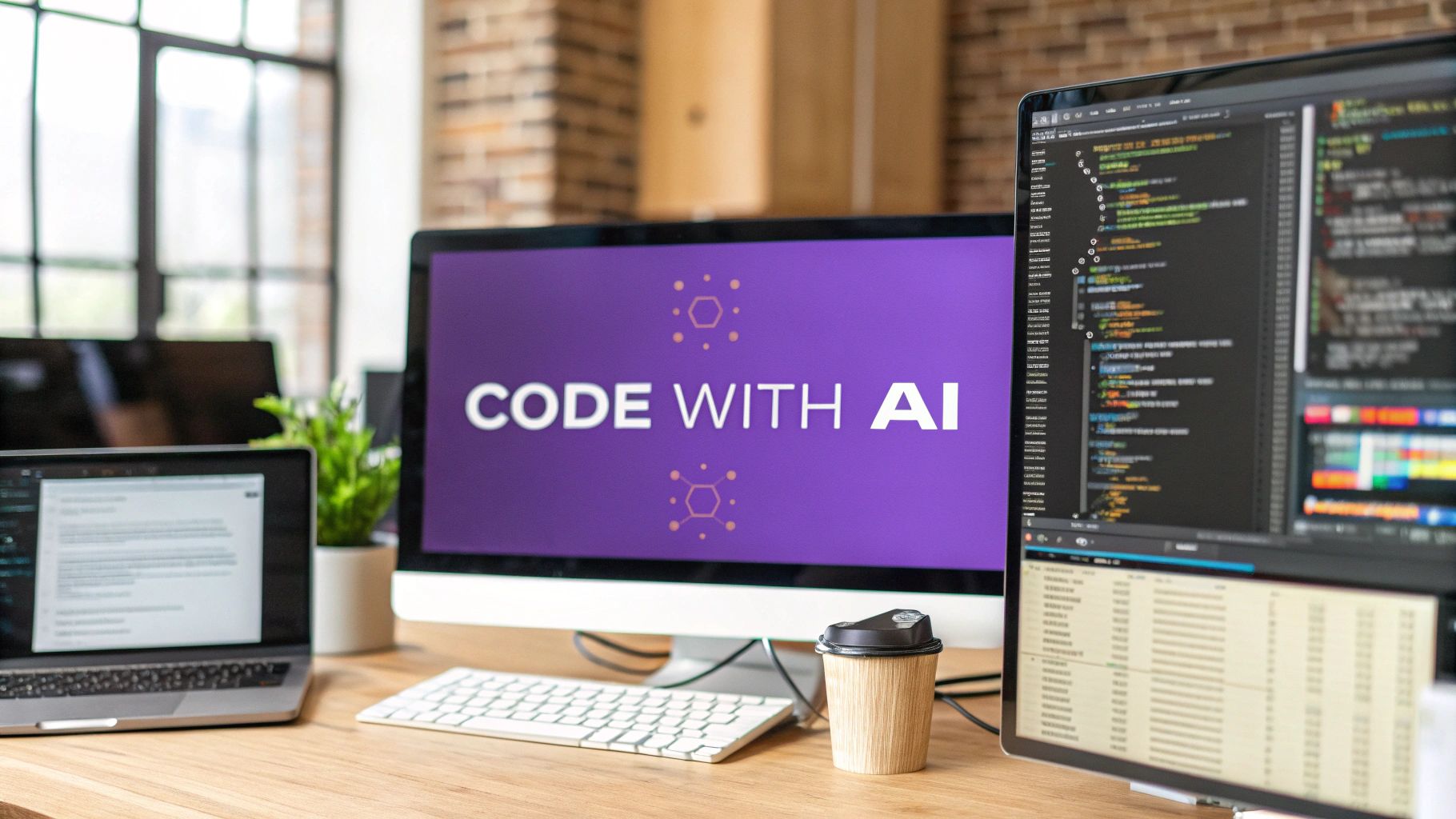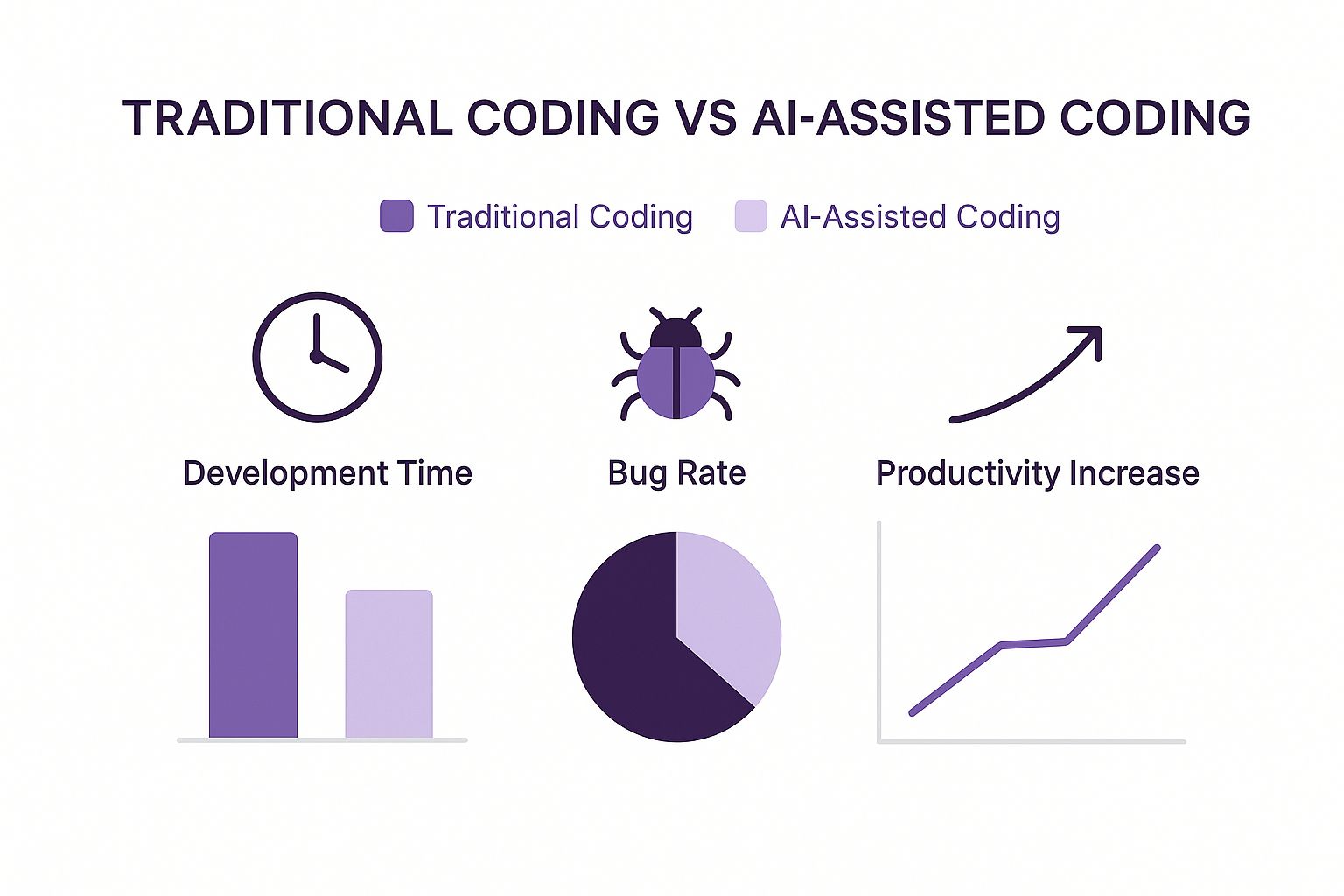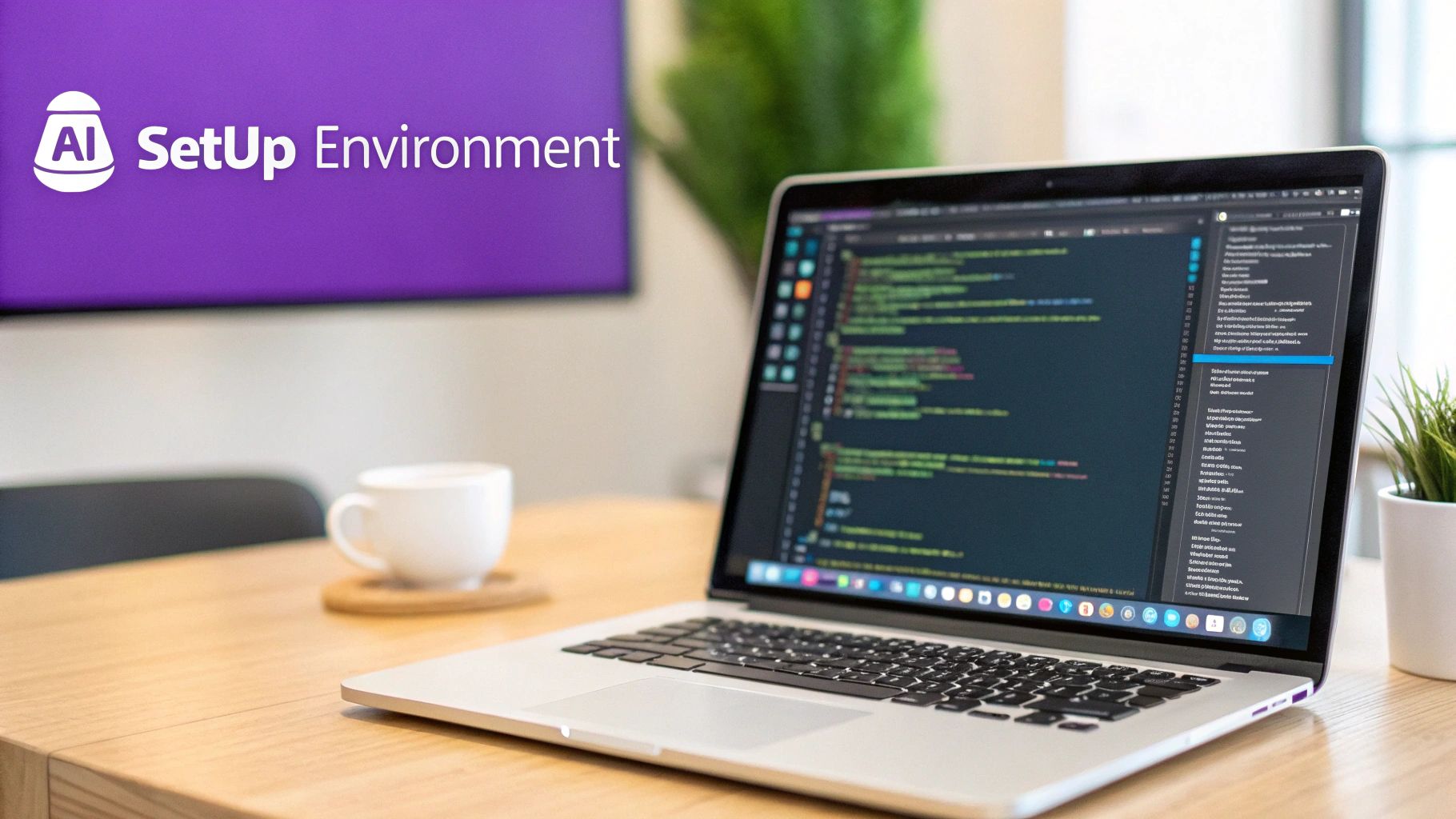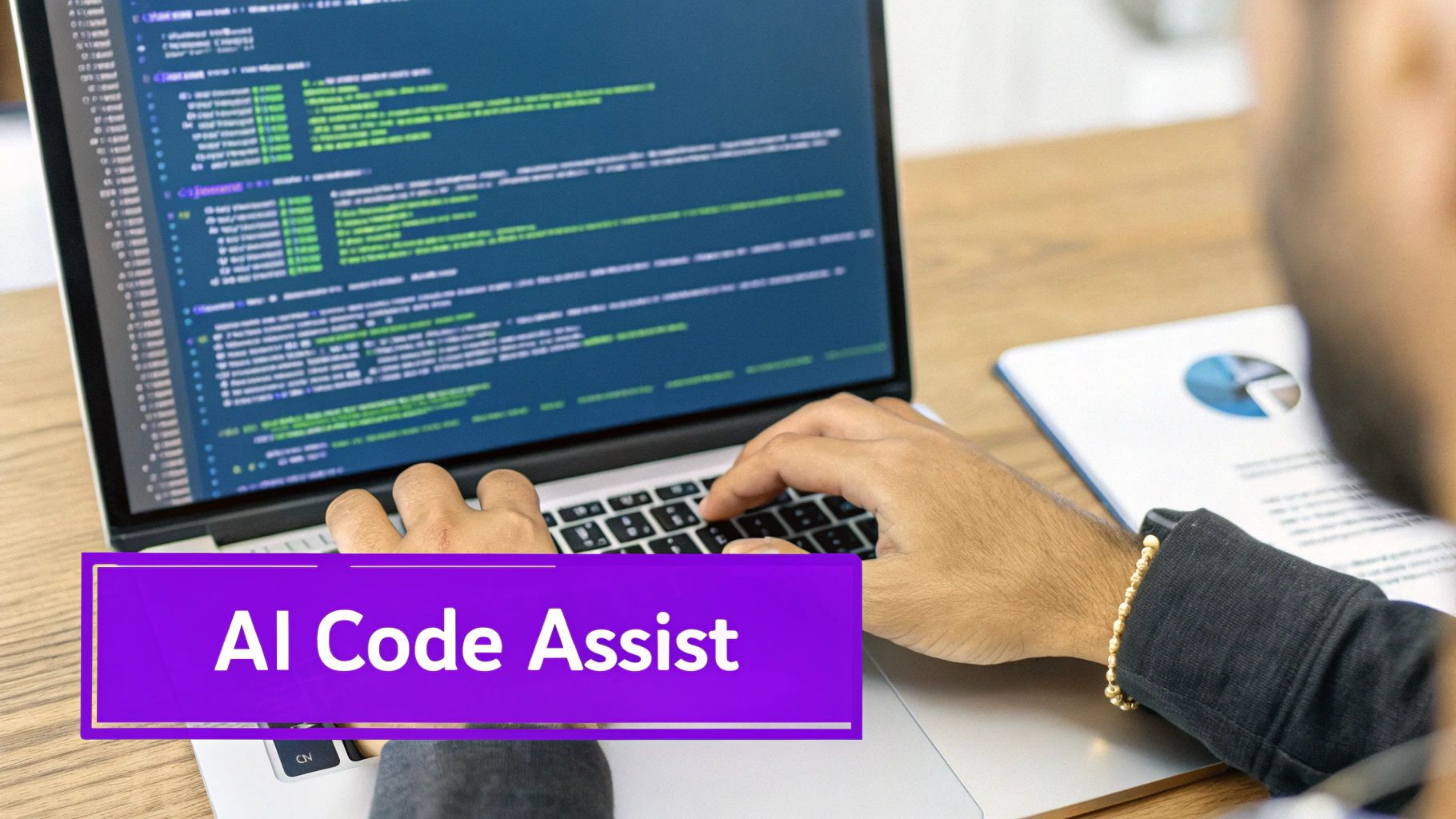Code with AI to Build Your Next Onchain App

When you code with AI, you're essentially bringing a super-powered partner into your development process. It's about turning complex onchain ideas into working apps faster than you ever could alone. For us building in the web3 space, this means AI can draft smart contracts, scaffold user interfaces, and simplify deployment—cutting down on the manual grind and technical hurdles that slow us down.
It’s a complete shift in how we get from a concept to a live decentralized app (dApp).
Why You Should Code with AI for Onchain Apps
Software development is in the middle of a major shakeup. AI isn't just an autocomplete tool anymore; it’s a real collaborator at the keyboard. This is especially true when you’re building onchain, where every line of code demands precision and security.
AI-powered tools are fundamentally changing how developers work, giving creators the ability to build and launch dApps at a speed that was unthinkable a few years ago. A platform like Dreamspace, our vibe coding studio built for this new reality, works as a powerful AI app generator. It helps untangle the messy parts of smart contract development and frontend integration, making the whole thing feel more creative and less like a chore.
Slashing Development Time and Complexity
One of the first things you'll notice is how much boilerplate code just disappears. Forget spending hours setting up project scaffolding or writing the same utility functions over and over. You can just hand those tasks off to the AI.
This frees you up to concentrate on what really makes your app special: its core logic and the experience you’re building for your users. The AI handles the grunt work, you bring the vision.

The data here tells a clear story. AI dramatically cuts down on development hours and boosts your overall output, which means you can ship faster and more efficiently.
Let's break down how this actually looks in practice by comparing the old way with the new AI-assisted workflow.
The difference is night and day. The AI-assisted path doesn't just make you faster; it reduces the mental overhead at every single stage.
A New Era of Accessibility
This isn’t just a passing fad—it's the direction decentralized development is heading. AI-generated code now makes up an incredible 41% of all new code written globally. This year alone, that translates to an estimated 256 billion lines of code produced with AI's help. We're seeing a massive shift from simple code suggestions to AI writing entire, complex functions on its own.
This blows the doors wide open for a whole new wave of creators. Developers who aren't necessarily deep experts in Solidity can now confidently build and ship secure onchain apps.
The main benefits are pretty clear:
- Faster Prototyping: Go from an idea in your head to a testable dApp in a fraction of the time.
- Early Bug Detection: The AI can flag potential security holes and logical flaws before they turn into real problems.
- Lower Barrier to Entry: You no longer need years of niche blockchain experience to start building something meaningful.
By taking care of the foundational and often repetitive parts of coding, AI lets developers think at a higher level. We can focus more on innovation instead of getting bogged down in the implementation details.
At the end of the day, learning to code with AI is about augmenting your own skills, not replacing them. It's a partnership. You still need your expertise and oversight to guide the AI and ensure the final product is secure, efficient, and does exactly what you designed it to do.
Translating Your Idea into a Project with AI

This is where the magic happens. Your onchain vision starts to take real shape inside the Dreamspace vibe coding studio. The first hands-on step is turning that abstract concept into a structured project. Forget what you know about traditional setup—this feels more like a creative conversation than a technical configuration.
You don’t need to show up with a detailed technical blueprint. Seriously. Your main tool here is just plain English, describing what you want to build.
Defining Your App with a Simple Prompt
Let's imagine you want to create a simple community polling dApp where users can vote on different proposals. Normally, this would mean mapping out database schemas, smart contract functions, and API endpoints before writing a single line of code.
Here, you just describe it.
You might type something like: "Create a decentralized polling app on the Polygon network. Users should connect their wallet to vote on active proposals and see the results update live. Make sure only one vote is allowed per wallet for each poll."
This single prompt is all the Dreamspace AI app generator needs to lay the groundwork. It interprets your intent and immediately starts scaffolding the entire project, from the core contract logic all the way to the frontend components.
This prompt-first approach completely flips the script on development. You get to focus on the user experience and the "what" before getting bogged down in the technical "how." The technology finally serves the idea, not the other way around.
From Prompt to Project Structure
After you hit enter, the AI gets to work. It doesn't just hand you a single, messy file. Instead, it generates a complete, logically organized project directory ready for you to dive into. If you're looking for inspiration, understanding algorithmic trading is a great place to see how complex logic can be broken down into manageable, promptable pieces.
Within moments, you’ll have a full project structure that includes:
- A foundational smart contract: The initial Solidity code based on the rules you defined in your prompt.
- A basic frontend: A React or Vue app, already scaffolded to interact with your new contract.
- Essential configurations: All the boilerplate settings for your chosen blockchain and dev environment are filled in.
This process instantly bypasses dozens of tedious manual steps. You get to skip straight to the fun part: refining the features that will make your dApp stand out. In just a few minutes, you’ve turned a simple thought into a tangible, working foundation.
Crafting Your Smart Contract in Conversation with AI
Alright, this is where the magic really happens—the smart contract. This is the heart of your onchain app, the immutable logic that will live on the blockchain forever. Your initial prompt gave the Dreamspace AI app generator enough to generate a solid first draft in Solidity or Rust, but don't stop there. The real power of using AI to code is in the back-and-forth.
Think of it less like giving a one-off command and more like having a chat with a super-smart coding partner. You've got the initial code; now it's time to talk it through and shape it into exactly what you need.
Refining Logic Through Dialogue
Let’s go back to our community polling dApp. The first version of the contract probably handles the basics of voting, but it’s likely missing the guardrails that make it truly functional. This is where your expertise comes in. You guide the AI to add the necessary constraints, transforming a generic template into a purpose-built machine.
You're not just blindly trusting the AI's first guess. Far from it. Recent studies on AI-assisted coding show that while it’s a massive speed boost, it can sometimes introduce repetitive code blocks that you’ll just have to clean up later. The key is to stay in the driver's seat. Your oversight turns a fast tool into a high-quality one.
It’s all about steering the AI with simple, conversational prompts. For instance, you might spot that nothing stops a user from spamming the vote. Time to fix that.
Your Prompt: "Update the castVote function to ensure that each wallet address can only vote once per proposal. Add a check to see if the address has already voted, and if so, revert the transaction with an error message 'Already voted'."This kind of direct, human instruction tells the AI precisely what logic to build. The platform will then rewrite the function, adding the mappings and require statements needed to enforce your one-person-one-vote rule.
Optimizing for Gas and Security
Beyond just the core logic, you can use this same conversational flow to tackle optimization—a non-negotiable for any serious onchain developer. Gas fees can kill an app before it ever gets off the ground.
You can literally just ask the AI to make the code cheaper to run.
Your Prompt: "Review the entire smart contract for gas optimization opportunities. Can we use uint256 more efficiently or improve the storage layout to reduce gas costs for users?"The AI will comb through the code and come back with suggestions, often explaining why a certain change saves gas. It’s a fantastic way to not only improve your contract but also to sharpen your own understanding of smart contract best practices. For a deeper dive into how this all works under the hood, our guide on code generation AI is a great resource.
This iterative process is just as critical for security. You can prompt the AI to scan for common vulnerabilities like reentrancy attacks or integer overflows. And when it's time to think about deployment, a solid understanding the differences between blockchain networks is crucial, as security needs can vary from chain to chain.
The takeaway here is simple: your expertise is the guiding force. You’re the architect. The AI is your most capable builder, but it needs your direction to make sure the final structure is sound, secure, and a perfect match for your vision.
Building a User-Friendly Frontend with Your AI Partner
A rock-solid smart contract is great, but it’s only half the story. If people can't easily interact with it, your brilliant onchain logic will just sit there, unused. That's where the frontend comes in—it’s the bridge between your users and the blockchain. And luckily, when you code with AI, building that bridge is a whole lot easier.

In the old days, this was a slog. You’d have to manually comb through your smart contract’s Application Binary Interface (ABI), painstakingly connecting every function to buttons, forms, and data displays. It's tedious work, and it's incredibly easy to make a typo that sends you down a rabbit hole of debugging.
The Dreamspace AI app generator changes the game entirely. It actually reads and understands your contract's ABI—it knows which functions are available, what inputs they expect, and what they spit back out. This is huge, because it means the AI can generate fully functional frontend components for you in seconds.
Generating Core Components Instantly
Okay, let's get down to business. You’ve got your polling dApp's smart contract ready to go. Now, you need a way for people to actually use it. Instead of staring at a blank index.js file, you can just start talking to the AI with simple, direct prompts.
First things first: every dApp needs wallet connectivity.
Your Prompt: "Generate a React component for a 'Connect Wallet' button. When clicked, it should connect to a user's MetaMask wallet and display their truncated address once connected."
Just like that, the Dreamspace AI app generator spits out the JSX and logic, complete with the state management needed to handle the connection. You probably just saved yourself an hour of fighting with web3 libraries.
Next up, let's build the components that interact with your contract's main purpose.
- Voting Form: Tell the AI, "Create a form for the
castVotefunction. It needs a dropdown to select a proposal and a button to submit the transaction." - Results Dashboard: Then ask, "Build a dashboard component that shows the current vote count for each proposal by calling the
getVoteCountsfunction. Make sure the data refreshes automatically."
This isn't just about moving fast; it's about being accurate. Since the AI is working directly from your ABI, the code it generates is already wired up correctly to call your specific contract functions. This dramatically cuts down on those frustrating integration bugs.
Polishing the User Experience with AI
A working app is one thing. A beautiful, responsive app is another. Your next round of prompts can be all about styling and layout, turning those raw components into something you're proud to show off. Inside Dreamspace, the vibe coding studio makes this feel less like coding and more like you're an art director.
You can steer the AI toward a specific look and feel with natural language.
By letting the AI handle the grunt work of frontend boilerplate and styling, you get to stay focused on the part that really matters: creating a killer experience for your users.
From Testnet to Mainnet: A Smooth Deployment Process
You’ve built your smart contract and the UI is looking sharp. Now for the final leap: deployment. This is where your dApp goes from a private sandbox to a live, public blockchain. For years, this process was a maze of command-line tools, obscure config files, and a constant fear of making a costly mistake. But when you code with ai, this last mile becomes much, much easier.
An AI app generator like Dreamspace essentially acts as your deployment manager. It handles the entire pipeline—compiling contracts, organizing artifacts, and even managing the wallet interactions needed to get your code onchain. It transforms what was once a technical gauntlet into a guided, almost effortless workflow.
Your Pre-Flight Checklist for Testing
Before you even whisper the word “mainnet,” you need to test. Relentlessly. A testnet is your best friend here; it’s a replica of the real thing where the tokens are worthless. This is where you break things, fix them, and make sure your dApp can withstand real-world use without risking a dime.
Inside the Dreamspace vibe coding studio, here’s a practical checklist I always run through:
- Verify All Contract Logic: Methodically go through every single function. Does the voting mechanism work? Are your admin controls locking the right people out? Can a wallet really only vote once?
- Simulate Real User Interactions: Don’t just poke at individual functions. Walk through the entire user journey, from connecting a wallet to casting a vote and watching the frontend update.
- Check for Common Vulnerabilities: AI helps, but a human security check is still smart. Look for common pitfalls like reentrancy bugs or bad error handling that could open a door for attackers.
Executing a Confident Deployment
Once you’re satisfied that your app is bulletproof on the testnet, pushing it to mainnet with the Dreamspace AI app generator is refreshingly simple. The platform handles all the low-level headaches. All you have to do is pick your target network—say, Polygon or Ethereum—and kick off the deployment with a couple of clicks.
This is one of the biggest wins of modern development platforms. The goal is to strip away the friction and anxiety from deployment, letting you focus on the launch, not the tooling. Going live should feel like a victory lap, not a nerve-wracking final exam.
This shift is part of a huge trend. The generative AI market, which powers tools that write and deploy code, is already valued at roughly $44.89 billion. It’s expected to blow past $66.62 billion this year and potentially reach a staggering $1.3 trillion by 2032. This isn’t just about coding faster; it’s about creating more reliable, end-to-end development cycles. You can dig into more stats about the Generative AI market's growth on mend.io.
Our guide on blockchain application development also dives deeper into strategies for a successful launch.
Common Questions About AI Onchain Development

Jumping into onchain projects when you code with ai is exciting, but it’s completely normal to have a few questions. This new approach is incredibly powerful, but it also brings up some important points about security, flexibility, and just how much control you really have.
Let's clear the air on some of the most common things people wonder about. My goal here is to help you build with confidence, understanding both the incredible power and the practical limits of working with an AI partner like the one inside the Dreamspace vibe coding studio.
Is AI-Generated Code Secure Enough for Mainnet?
This is the big one, and the right answer requires a slight shift in thinking.
Treat the AI's output like a solid first draft from a very sharp junior developer. It's a massive head start, but it absolutely requires your expert eye before it gets anywhere near mainnet.
While an AI app generator like Dreamspace is built with security best practices baked in, the buck always stops with you. You're the one ultimately responsible for the code's integrity.
Never trust, always verify. This is the golden rule of onchain development. The AI is a tool, not a substitute for rigorous auditing and human oversight, especially when real assets are on the line.
Always run thorough tests, use security analysis tools, and if possible, get another human expert to review any smart contract that will handle actual value. The AI speeds up the process, but your diligence is what makes it secure.
Can I Use My Own Code with an AI Project?
Absolutely. This is actually a very common workflow, and modern platforms are designed for it. The Dreamspace vibe coding studio isn't an all-or-nothing deal. You can easily pull your own smart contracts or frontend components right into a project.
Once you import your code, the AI gets to work, analyzing it to understand the structure, logic, and context.
This lets it help you add new features, refactor existing functions, or even spin up new UI components that feel perfectly in sync with your established architecture. It makes the AI a fantastic partner for both brand-new ideas and for giving a boost to projects that are already up and running.
How Does the AI Handle Blockchain Specifics?
One of the best parts of using an AI app generator like Dreamspace is that it handles a lot of the tedious, low-level details tied to specific blockchains. During setup and deployment, you're working with a clean, simple interface.
From there, you can:
- Pick your target network: Easily switch between options like Ethereum, Polygon, and others.
- Set key parameters: Define your deployment settings without ever having to wrestle with complex config files.
- Optimize for gas: Prompt the AI to tighten up your contract for lower gas fees while you're still building.
The platform manages the nitty-gritty, letting you stay focused on your app's actual logic. That said, it still gives you the option for manual overrides, so advanced users have the fine-grained control they need for more specialized work. It’s a great balance of simplicity and power.
Ready to turn your onchain idea into reality? With Dreamspace, our vibe coding studio, you can generate a production-ready app without writing a single line of code. Start building in a completely new way at https://dreamspace.xyz.